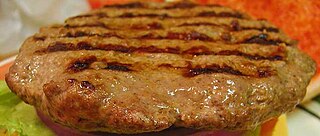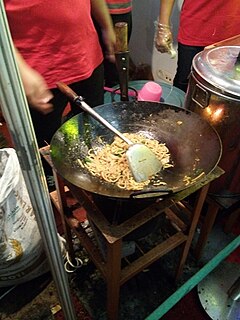
A pie is a baked dish which is usually made of a pastry dough casing that contains a filling of various sweet or savoury ingredients. Sweet pies may be filled with fruit, nuts, brown sugar or sweetened vegetables. Savoury pies may be filled with meat, eggs and cheese (quiche) or a mixture of meat and vegetables.

A samosa is a fried or baked pastry with a savory filling, such as spiced potatoes, onions, peas, cheese, beef and other meats, or lentils. It may take different forms, including triangular, cone, or half-moon shapes, depending on the region. The Indian style, often accompanied by a chutney, is probably the most widely known of a broad family of recipes from Africa to China, which have origins in medieval times or earlier. Samosas are a popular entrée, appetizer, or snack in the local cuisines of South Asia, Western Asia, Southeast Asia, the Mediterranean, and Africa. Due to emigration and cultural diffusion from these areas, samosas today are often prepared in other regions.

A turnover is a type of pastry or bread made by placing a filling on a piece of dough, folding the dough over, sealing, and baking it. Turnovers can be sweet or savory and are often made as a sort of portable meal or dessert, similar to a sandwich. They are often eaten for breakfast.

A Jamaican patty is a pastry that contains various fillings and spices baked inside a flaky shell, often tinted golden yellow with an egg yolk mixture or turmeric. It is made like a turnover, but is more savoury and filled with meat. As its name suggests, it is commonly found in Jamaica, and is also eaten in other areas of the Caribbean, such as the Caribbean coast of Nicaragua and Costa Rica. It is traditionally filled with seasoned ground beef, but fillings can include chicken, pork, lamb, vegetables, shrimp, lobster, fish, soy, ackee, mixed vegetables or cheese. In Jamaica, the patty is often eaten as a full meal, especially when paired with coco bread. It can also be made as bite-sized portions called cocktail patties. Among the Jamaican diaspora in the United Kingdom, the pastry is more like that of a suet crust, and often made with margarine or butter, which provides the flaky pastry, and curry powder containing turmeric, which provides the yellow colour. In the United Kingdom, Island Delight Jamaican Patties are prevalent amongst retailers and consumers.
The city of Ipoh is the administrative capital of the Malaysian state of Perak and is famous for its cuisine. Its food culture is driven by its majority Chinese population who are largely of Cantonese and Hakka descent. There is also excellent Malay and Indian food in Ipoh; the nasi kandar served by a prominent local Mamak stall is nicknamed nasi ganja due to its supposed addictive properties. Specialty foods from neighbouring towns are also available in Ipoh.

Mie kari is an Asian dish originated from the Maritime Southeast Asian community particularly in the region of Indonesia and Malaysia. This dish is so well accepted, it has been made into fusion food of other nationalities in the Southeast Asian Region. It is called mee kari widely in Malaysia, curry mee in northern part of the Malaysia, and mi kari or mie kari in Indonesia. In other places where this dish has been made fusion, it is called "curry laksa". The dish is unique to Malaysia, Singapore, and Indonesia. It might have been influenced by Indonesian cuisine, Malaysian cuisine, Chinese cuisine and Indian cuisine.

A curry puff is a snack of Malayan origin. It is a small pie consisting of curry with chicken and potatoes in a deep-fried or baked pastry shell. The curry is quite thick to prevent it from oozing out of the snack.

Yellow curry is a curry made from cumin, coriander, turmeric, fenugreek, garlic, salt, bay leaf, lemongrass, cayenne pepper, ginger, mace and cinnamon. It generally contains less chilli than other curries.

A patty is a flattened, usually round, serving of ground meat and/or legumes, grains, vegetables, or meat alternatives. Patties are found in multiple cuisines throughout the world.

Marry girl cake or dowry cake is a traditional Chinese pastry that was once a ceremonial cake used as a wedding gift in the traditional Chinese wedding ceremony, hence the name. Today, this cake is known more as a classic Chinese pastry rather than a wedding gift because it has lost most of its original significance due to cultural change. It can be found in Hong Kong and in some Chinatowns overseas.

Ham and egg bun is a type of Hong Kong pastry. It is a bun or bread that contains a sheet of egg and ham. It is commonly found in Hong Kong as well as some Chinatown bakery shops overseas. It is also a common meal in Brazil, called simply as sandwich.

Ox-tongue pastry or horse-ear pastry, also referred to as Chinese Doughnut, is a Chinese pastry that is popular in south China in the provinces of Guangdong and Fujian. It is a fried dough food that is elliptical in shape and resembles an ox tongue or a horse ear. The pastry texture is chewy, with a soft interior and a crunchy crust. Ox-tongue pastry is lightly sweetened, and eaten as part of breakfast with soy milk. The pastry is made in a similar way as Youtiao, however, sugar is added to the flour.

Chebureki is a deep-fried turnover with a filling of ground or minced meat and onions. It is made with a single round piece of dough folded over the filling in a crescent shape.

Pineapple cake is a sweet traditional Taiwanese pastry containing butter, flour, egg, sugar, and pineapple jam or slices.

Beef bun is a type of Hong Kong pastry. It is one of the most standard pastries in Hong Kong and can also be found in most Chinatown bakery shops. The bun has a ground beef filling, sometimes including pieces of onions.

Jiaozi are a kind of Chinese dumpling, commonly eaten in China and other parts of East Asia. They are one of the major dishes eaten during the Chinese New Year and year-round in the northern provinces. Though considered part of Chinese cuisine, jiaozi are popular in other parts of East Asia and in the Western world, where they are sometimes called “pot stickers”.

Arab Indonesian cuisine is characterized by the mixture of Middle Eastern cuisine with local Indonesian-style. Arab Indonesians brought their legacy of Arab cuisine—originally from Hadhramaut, Hejaz and Egypt—and modified some of the dishes with the addition of Indonesian ingredients. The Arabs arrived in the Nusantara archipelago to trading and spread Islam. In Java, since the 18th century AD, most of Arab traders settled on the north coast and diffuse with indigenous, thus affecting the local cuisine culture, especially in the use of mutton meat and ghee in cooking.

Indian Indonesian cuisine is characterized by the mixture of Indian cuisine with local Indonesian-style. This cuisine consists of adaptations of authentic dishes from India, as well as original creations inspired by the diverse food culture of Indonesia. Indian influence can be observed in Indonesia as early as the 4th century. Following the spread of Islam to Indonesia and trading, Muslim Indian as well as Arab influences made their way into Indonesian cuisine. Examples include Indian biryani, murtabak, curry and paratha that influenced Acehnese, Minangkabau, Malay, Palembangese, Betawi and Javanese cuisine.

Indonesian noodles are a significant aspect of Indonesian cuisine which is very diverse. Indonesian cuisine recognised many types of noodles, with each regions often developed their distinct recipes.



















